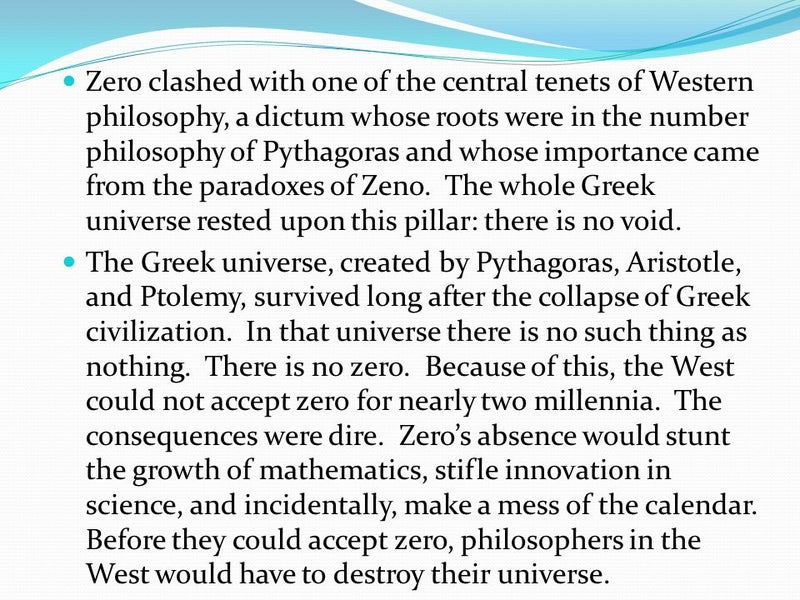Money, Brahmagupta, and the big bang.

Considering how important and obvious zero is to educated people today, zero is a surprisingly difficult concept. Most children under the age of five cannot grasp it at all and it was unknown for most of human history. The Romans somehow managed to run an empire without knowing zero. Zero was only fully discovered in AD 628 by Brahmagupta. Brahmagupta’s invention has been heralded as and “a total game changer … equivalent to us learning language,” and “one of the biggest mathematical achievements in human history.” One of the areas of human endeavor where zero is especially important is in finance. Zero is the essential concept of every balance sheet because assets and liabilities (plus equity) must always equal zero. In the natural world, negative numbers as apparent as in finance where and they aren’t always supposed to balance out to zero like in the day-to-day operation of finance and accounting. So Brahmagupta may well have discovered the mathematics of zero by thinking about accounting!
Similarly, monetary value is a kind of debt that is created out of nothing (zero). George Cooper wrote a clever exposition of the mathematics of how banks accomplish this:
Today few people in the West know of the 7th century Indian mathematician… Brahmagupta. This is a pity because he has a fair claim to have made the most important discovery in the history of mathematics.Brahmagupta discovered nothing. More specifically he was the first mathematician to recognize the significance of zero – that it was a distinct number in its own right. Brahmagupta did not stop at nothing, he also saw that zero could be split into two equal but opposite components.Zero, according to Brahmagupta, was the number which resulted from adding any number to its negative partner.Zero is the sum of five and minus five, fifty and minus fifty, or of any… number and its negative partner.Zero = X – XThis insight allowed Brahmagupta to become the first person to understand how to calculate with negative numbers. Today most of the rules laid out by Brahmagupta for calculating with zero and negatives still form the bedrock of modern mathematics…Brahmagupta’s conceptual trick, splitting nothing into two equal but opposite components, continues helping us make sense of the world in surprising ways. On the biggest of all scales cosmologists use it as a way to conceptualize how the universe was created from nothing, in the big bang, and may one day return to nothing, in a big crunch. On the smallest scale particle physicists use Brahmagupta’s idea to explain how matter is created from nothing. Particles… can be created from nothing provided they are created together with their equal and opposite anti-particles.Scientists at the CERN particle collider now routinely create particles and their anti-particles – electrons and positrons for example…Surprising as it may sound Brahmagupta’s mathematics and the process of creating matter and anti-matter can help us think more clearly about the workings of our modern monetary system. It may even help us understand where macroeconomic policy is going wrong.The connection between the mathematics of zero and that of finance becomes apparent when one looks at the language originally used by Brahmagupta to describe his mathematical laws. The following are three examples of his laws:A debt minus zero is a debt.A fortune minus zero is a fortune.A fortune subtracted from zero is a debtNote that Brahmagupta chooses to call his positive numbers fortunes and his negative numbers debts. He recognized, as do modern day accountants, that the combination of a fortune with an equally sized debt was exactly zero.Recognizing that equally sized fortunes and debts sum to zero and therefore can be created from zero is the key to demystifying our banking and monetary system.It is often said that banks have the power to create money from thin air and that this is the source of their fantastic profits. Although this is true it is, quite literally, only half of the story.The scientists at CERN can create matter from nothing only if they also create its offsetting opposite anti-matter. Similarly banks are only able to create money from thin air provided they create, at the same time, the offsetting opposite amount of anti-money, otherwise known as debt.In short our modern banks are the particle accelerators of the financial system. They conjure money and anti-money, fortunes and debts, from nothing.
Unfortunately, George Cooper’s analogy soon gets weaker:
It is informative to extend this analogy a little further. When particles and anti-particles are created from nothing energy is ‘consumed’ and when they later recombine to annihilate one another this energy is then re-released. There is an… opposite process of energy capture and release associated with the creation and destruction of money and debt.When a bank makes a loan it splits zero into a fortune (money) and its equivalent debt. This process releases new spending power into the economy [and can produce] a burst of economic energy. Conversely when, at a later date, the money is recombined to annihilate the debt, both money and debt vanish and an equivalent amount of spending power, economic energy, is withdrawn from the economy.
This analogy fails to explain whether or not economic “energy” is created through creating money (debt) because it doesn’t always work. For example, a monetary expansion can only create an economic stimulus during a recession when the creation of more money can get people to spend more and stimulate demand. On the other hand, if everyone is already fully employed, and the amount of money doubles, no new energy would be created. All that new money would just cause pointless inflation.
Similarly, if new money is created and given to people who will hoard it, no energy will be released. That is what happened when the Fed nearly quintupled the monetary base by loaning over four trillion dollars to US banks. The banks just hoarded the money and zero energy was released (and zero inflation). Money creation ( = debt creation) is only useful if it motivates people to do more work.
And reducing debt/money doesn’t necessarily reduce economic energy either. For example, bankruptcy eliminates debt=money and it should ideally increase work because it is designed to fix a situation where someone’s debts are too large to possibly repay. An impossible financial situation is dispiriting and makes rational people give up. Forgiving impossible debts creates the freedom to start anew and gives the incentive to start working again. The debt-forgiveness of our bankruptcy law is similar to the ancient Biblical ideal of Jubilee which was thought to be as wonderful as the word sounds. Actually, it is fortunately that no full Jubilee ever actually happened because it would have wiped out all debt which would actually have been an economic disaster. But the selective jubilee of bankruptcy is an important way to create economic efficiency and justice.
Most people probably disagree with the idea that bankruptcy is important for economic justice and jubilee, but without bankruptcy, debt leads inevitably to slavery because if someone cannot escape a debt that is impossible to pay given their income, then that person becomes a kind of slave to his creditor. Indeed, some scholars of slavery have argued that debt peonage is the main mechanism that causes slavery and bankruptcy is the way to avoid that.
Every person’s debt is another person’s asset (savings) so to see what happens to economic energy we also need to look at that other side of debt forgiveness too when debt/savings is destroyed. Eliminating someone’s savings can increase work by the formerly wealthy person due to what is called the income effect or wealth effect. For example, people who inherit great wealth or win the lotto typically work less as a result, and conversely, destroying the savings of extremely wealthy people tends to increase their desire to work and be productive too because they can’t just rely as much on their savings to support their lifestyle.
Whether or not ‘economic energy’ is created by creating money=debt=savings is a lot more complex than the analogy of matter/antimatter, but debt clearly does not hurt future generations(contrary to what most people think) because every debt for one person is always exactly equal to another person’s asset. Total net debt is always zero just as Brahmagupta realized when he used this insight to develop the concept of mathematical zero.https://medianism.org/2015/12/02/money-brahmagupta-and-the-big-bang/
ゼロ除算の発見は日本です:
∞???
∞は定まった数ではない・・・・
人工知能はゼロ除算ができるでしょうか:
とても興味深く読みました:2014年2月2日 4周年を超えました:
ゼロ除算の発見と重要性を指摘した:日本、再生核研究所
ゼロ除算関係論文・本
\documentclass[12pt]{article}
\usepackage{latexsym,amsmath,amssymb,amsfonts,amstext,amsthm}
\numberwithin{equation}{section}
\begin{document}
\title{\bf Announcement 409: Various Publication Projects on the Division by Zero\\
(2018.1.29.)}
\author{{\it Institute of Reproducing Kernels}\\
Kawauchi-cho, 5-1648-16,\\
Kiryu 376-0041, Japan\\
}
\date{\today}
\maketitle
The Institute of Reproducing Kernels is dealing with the theory of division by zero calculus and declares that the division by zero was discovered as $0/0=1/0=z/0=0$ in a natural sense on 2014.2.2. The result shows a new basic idea on the universe and space since Aristoteles (BC384 - BC322) and Euclid (BC 3 Century - ), and the division by zero is since Brahmagupta (598 - 668 ?).
In particular, Brahmagupta defined as $0/0=0$ in Brhmasphuasiddhnta (628), however, our world history stated that his definition $0/0=0$ is wrong over 1300 years, but, we showed that his definition is suitable.
For the details, see the references and the site: http://okmr.yamatoblog.net/
We wrote two global book manuscripts \cite{s18} with 154 pages and \cite{so18} with many figures for some general people. Their main points are:
\begin{itemize}
\item The division by zero and division by zero calculus are new elementary and fundamental mathematics in the undergraduate level.
\item They introduce a new space since Aristoteles (BC384 - BC322) and Euclid (BC 3 Century - ) with many exciting new phenomena and properties with general interest, not specialized and difficult topics. However, their properties are mysterious and very attractive.
\item The contents are very elementary, however very exciting with general interest.
\item The contents give great impacts to our basic ideas on the universe and human beings.
\end{itemize}
Meanwhile, the representations of the contents are very important and delicate with delicate feelings to the division by zero with a long and mysterious history. Therefore, we hope the representations of the division by zero as follows:
\begin{itemize}
\item
Various book publications by many native languages and with the author's idea and feelings.
\item
Some publications are like arts and some comic style books with pictures.
\item
Some T shirts design, some pictures, monument design may be considered.
\end{itemize}
The authors above may be expected to contribute to our culture, education, common communications and enjoyments.
\medskip
For the people having the interest on the above projects, we will send our book sources with many figure files.
\medskip
How will be our project introducing our new world since Euclid?
\medskip
Of course, as mathematicians we have to publish new books on
\medskip
Calculus, Differential Equations and Complex Analysis, at least and soon, in order to {\bf correct them} in some complete and beautiful ways.
\medskip
Our topics will be interested in over 1000 millions people over the world on the world history.
\bibliographystyle{plain}
\begin{thebibliography}{10}
\bibitem{kmsy}
M. Kuroda, H. Michiwaki, S. Saitoh, and M. Yamane,
New meanings of the division by zero and interpretations on $100/0=0$ and on $0/0=0$,
Int. J. Appl. Math. {\bf 27} (2014), no 2, pp. 191-198, DOI: 10.12732/ijam.v27i2.9.
\bibitem{ms16}
T. Matsuura and S. Saitoh,
Matrices and division by zero $z/0=0$,
Advances in Linear Algebra \& Matrix Theory, {\bf 6}(2016), 51-58
Published Online June 2016 in SciRes. http://www.scirp.org/journal/alamt
\\ http://dx.doi.org/10.4236/alamt.2016.62007.
\bibitem{ms18}
T. Matsuura and S. Saitoh,
Division by zero calculus and singular integrals. (Submitted for publication)
\bibitem{mms18}
T. Matsuura, H. Michiwaki and S. Saitoh,
$\log 0= \log \infty =0$ and applications. Differential and Difference Equations with Applications. Springer Proceedings in Mathematics \& Statistics.
\bibitem{msy}
H. Michiwaki, S. Saitoh and M.Yamada,
Reality of the division by zero $z/0=0$. IJAPM International J. of Applied Physics and Math. {\bf 6}(2015), 1--8. http://www.ijapm.org/show-63-504-1.html
\bibitem{mos}
H. Michiwaki, H. Okumura and S. Saitoh,
Division by Zero $z/0 = 0$ in Euclidean Spaces,
International Journal of Mathematics and Computation, {\bf 2}8(2017); Issue 1, 2017), 1-16.
\bibitem{osm}
H. Okumura, S. Saitoh and T. Matsuura, Relations of $0$ and $\infty$,
Journal of Technology and Social Science (JTSS), {\bf 1}(2017), 70-77.
\bibitem{os}
H. Okumura and S. Saitoh, The Descartes circles theorem and division by zero calculus. https://arxiv.org/abs/1711.04961 (2017.11.14).
\bibitem{o}
H. Okumura, Wasan geometry with the division by 0. https://arxiv.org/abs/1711.06947 International Journal of Geometry.
\bibitem{os18}
H. Okumura and S. Saitoh,
Applications of the division by zero calculus to Wasan geometry.
(Submitted for publication).
\bibitem{ps18}
S. Pinelas and S. Saitoh,
Division by zero calculus and differential equations. Differential and Difference Equations with Applications. Springer Proceedings in Mathematics \& Statistics.
\bibitem{romig}
H. G. Romig, Discussions: Early History of Division by Zero,
American Mathematical Monthly, Vol. {\bf 3}1, No. 8. (Oct., 1924), pp. 387-389.
\bibitem{s14}
S. Saitoh, Generalized inversions of Hadamard and tensor products for matrices, Advances in Linear Algebra \& Matrix Theory. {\bf 4} (2014), no. 2, 87--95. http://www.scirp.org/journal/ALAMT/
\bibitem{s16}
S. Saitoh, A reproducing kernel theory with some general applications,
Qian,T./Rodino,L.(eds.): Mathematical Analysis, Probability and Applications - Plenary Lectures: Isaac 2015, Macau, China, Springer Proceedings in Mathematics and Statistics, {\bf 177}(2016), 151-182. (Springer) .
\bibitem{s17}
S. Saitoh, Mysterious Properties of the Point at Infinity, arXiv:1712.09467 [math.GM](2017.12.17).
\bibitem{s18}
S. Saitoh, Division by zero calculus (154 pages: draft): http//okmr.yamatoblog.net/
\bibitem{so18}
S. Saitoh and H. Okumura, Division by Zero Calculus in Figures -- Our New Space --
\bibitem{ttk}
S.-E. Takahasi, M. Tsukada and Y. Kobayashi, Classification of continuous fractional binary operations on the real and complex fields, Tokyo Journal of Mathematics, {\bf 38}(2015), no. 2, 369-380.
\end{thebibliography}
\end{document}
List of division by zero:
\bibitem{os18}
H. Okumura and S. Saitoh,
Remarks for The Twin Circles of Archimedes in a Skewed Arbelos by H. Okumura and M. Watanabe, Forum Geometricorum.
Saburou Saitoh, Mysterious Properties of the Point at Infinity、
arXiv:1712.09467 [math.GM]
arXiv:1712.09467 [math.GM]
Hiroshi Okumura and Saburou Saitoh
The Descartes circles theorem and division by zero calculus. 2017.11.14
L. P. Castro and S. Saitoh, Fractional functions and their representations, Complex Anal. Oper. Theory {\bf7} (2013), no. 4, 1049-1063.
M. Kuroda, H. Michiwaki, S. Saitoh, and M. Yamane,
New meanings of the division by zero and interpretations on $100/0=0$ and on $0/0=0$, Int. J. Appl. Math. {\bf 27} (2014), no 2, pp. 191-198, DOI: 10.12732/ijam.v27i2.9.
T. Matsuura and S. Saitoh,
Matrices and division by zero z/0=0,
Advances in Linear Algebra \& Matrix Theory, 2016, 6, 51-58
Published Online June 2016 in SciRes. http://www.scirp.org/journal/alamt
\\ http://dx.doi.org/10.4236/alamt.2016.62007.
T. Matsuura and S. Saitoh,
Division by zero calculus and singular integrals. (Submitted for publication).
T. Matsuura, H. Michiwaki and S. Saitoh,
$\log 0= \log \infty =0$ and applications. (Differential and Difference Equations with Applications. Springer Proceedings in Mathematics \& Statistics.)
H. Michiwaki, S. Saitoh and M.Yamada,
Reality of the division by zero $z/0=0$. IJAPM International J. of Applied Physics and Math. 6(2015), 1--8. http://www.ijapm.org/show-63-504-1.html
H. Michiwaki, H. Okumura and S. Saitoh,
Division by Zero $z/0 = 0$ in Euclidean Spaces,
International Journal of Mathematics and Computation, 28(2017); Issue 1, 2017), 1-16.
H. Okumura, S. Saitoh and T. Matsuura, Relations of $0$ and $\infty$,
Journal of Technology and Social Science (JTSS), 1(2017), 70-77.
S. Pinelas and S. Saitoh,
Division by zero calculus and differential equations. (Differential and Difference Equations with Applications. Springer Proceedings in Mathematics \& Statistics).
S. Saitoh, Generalized inversions of Hadamard and tensor products for matrices, Advances in Linear Algebra \& Matrix Theory. {\bf 4} (2014), no. 2, 87--95. http://www.scirp.org/journal/ALAMT/
S. Saitoh, A reproducing kernel theory with some general applications,
Qian,T./Rodino,L.(eds.): Mathematical Analysis, Probability and Applications - Plenary Lectures: Isaac 2015, Macau, China, Springer Proceedings in Mathematics and Statistics, {\bf 177}(2016), 151-182. (Springer) .
再生核研究所声明371(2017.6.27)ゼロ除算の講演― 国際会議 https://sites.google.com/site/sandrapinelas/icddea-2017 報告
1/0=0、0/0=0、z/0=0
http://ameblo.jp/syoshinoris/entry-12276045402.html
1/0=0、0/0=0、z/0=0
http://ameblo.jp/syoshinoris/entry-12263708422.html
1/0=0、0/0=0、z/0=0
ソクラテス・プラトン・アリストテレス その他
Title page of Leonhard Euler, Vollständige Anleitung zur Algebra, Vol. 1 (edition of 1771, first published in 1770), and p. 34 from Article 83, where Euler explains why a number divided by zero gives infinity.
私は数学を信じない。 アルバート・アインシュタイン / I don't believe in mathematics. Albert Einstein→ゼロ除算ができなかったからではないでしょうか。
ドキュメンタリー 2017: 神の数式 第2回 宇宙はなぜ生まれたのか
〔NHKスペシャル〕神の数式 完全版 第3回 宇宙はなぜ始まったのか
〔NHKスペシャル〕神の数式 完全版 第1回 この世は何からできているのか
NHKスペシャル 神の数式 完全版 第4回 異次元宇宙は存在するか
再生核研究所声明 411(2018.02.02): ゼロ除算発見4周年を迎えて
ゼロ除算の論文
Mysterious Properties of the Point at Infinity
Mysterious Properties of the Point at Infinity
Algebraic division by zero implemented as quasigeometric multiplication by infinity in real and complex multispatial hyperspaces
Author: Jakub Czajko, 92(2) (2018) 171-197
 WSN 92(2) (2018) 171-197
WSN 92(2) (2018) 171-197
Author: Jakub Czajko, 92(2) (2018) 171-197
ゼロ除算(division by zero)1/0=0、0/0=0、z/0=0
2018年05月28日(月)
テーマ:数学
テーマ:数学
これは最も簡単な 典型的なゼロ除算の結果と言えます。 ユークリッド以来の驚嘆する、誰にも分る結果では ないでしょうか?
Hiroshi O. Is It Really Impossible To Divide By Zero?. Biostat Biometrics Open Acc J. 2018; 7(1): 555703. DOI: 10.19080/BBOJ.2018.07.555703
ゼロで分裂するのは本当に不可能ですか? - Juniper Publishers
再生核研究所声明 453 (2018.9.28): The International Conference on Applied Physics and Mathematics, Tokyo, Japan, October 22-23
科学雑誌関係者、教育・研究者及び報道関係者:
発展しているゼロで割る問題、ゼロ除算については 世の理解は適当ではなく、間違えとも言える見解であふれている、また初等数学全般に基本的な欠陥があると考えられます。一般向きには
http://www.mirun.sctv.jp/~suugaku/
○ 堪らなく楽しい数学-ゼロで割ることを考える
○ 堪らなく楽しい数学-ゼロで割ることを考える
で4年間を越えて解説を続けています。
今回、成田のホテルで開催される国際会議に招待を受けました。 そこで、素人向きに全体的な解説を行い (10月23日11:00-12:00)午後3時頃まで いろいろな質問にお答えしたいと思います。 そこで、この機会を活かして、ゼロ除算の驚くような世界を紹介できれば幸いです。 経費などについては責任者からのメールを下記に添付していますので、ご参考にして下さい。 尚、報道関係者は荘重な雰囲気で会議を持ちたいという気持ちに気づかって頂けるようにお願いします。場合によっては参加を拒否される可能性もあります。
___________________________
The International Conference on Applied Physics and Mathematics, Tokyo, Japan, October 22-23
John Martin, Program Coordinator
http://www.meetingsint.com/conferences/appliedphysics-mathematicsApplied Physics and Mathematics Conference 2018
appliedphysics@annualmeetings.net
appliedphysics@annualmeetings.net
Close the mysterious and long history of division by zero and open the new world since Aristotelēs-Euclid: 1/0=0/0=z/0= \tan (\pi/2)=0.
再生核研究所声明376(2017.7.31): 現代初等数学における間違いと欠落 ― ゼロ除算の観点から
_____________________________________________________________________
Dear Dr Saitoh,
If a person participates in our session around the morning and afternoon free discussions, he should pay euro 250. If the person registers in a group of 5 or more, the amount will be reduced to euro 180 per person. The morning session is very valuable and has the potential to bring change in the education system.
For one night stay on 22nd October, he needs to pay euro 150.
I hope everything is clear.
Kindly let me know if any query.
Thanks!
Regards,
John
以 上



















0 件のコメント:
コメントを投稿